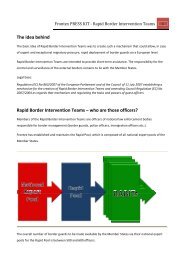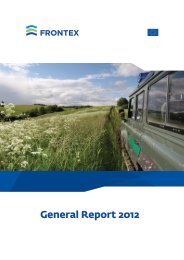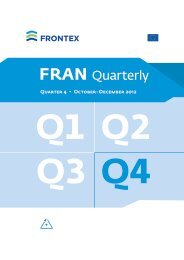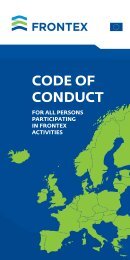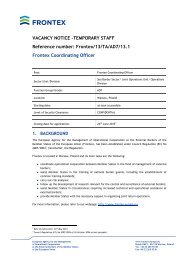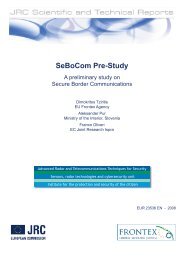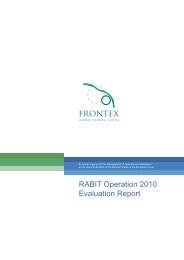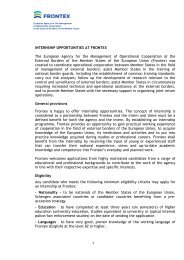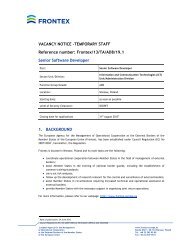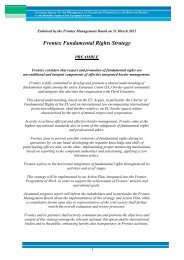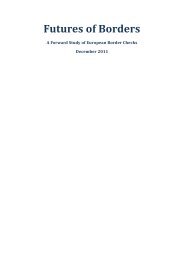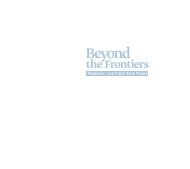Download PDF - Frontex
Download PDF - Frontex
Download PDF - Frontex
You also want an ePaper? Increase the reach of your titles
YUMPU automatically turns print PDFs into web optimized ePapers that Google loves.
1.7. Risks identified in the ARA 2012 and outlook of the situation at the<br />
external borders in 2013<br />
The following risks at the external borders of the EU were identified according to the results<br />
of an annual risk analysis process involving Member State analysts participating in the <strong>Frontex</strong><br />
Risk Analysis Network. They represent the main risks identified by the <strong>Frontex</strong> Risk Analysis<br />
Unit after an Annual Analytical Review with Member State analysts.<br />
The risks presented are a summary of the risks presented in the restricted version of the<br />
Annual Risk Analysis 2012 for the <strong>Frontex</strong> Management Board. This summary does not contain<br />
references to identified vulnerabilities, nor proposals for recommendations that were<br />
presented to the <strong>Frontex</strong> Management Board as a basis for their discussions in elaborating the<br />
Programme of Work for 2013.<br />
They are primarily aimed for strategic and long term planning purposes, and require specific<br />
tailored analysis for tactical and operational decisions.<br />
1.7.1. Risk of large and sustained numbers of illegal border-crossings at the<br />
external land and sea border with Turkey<br />
The border between Greece and Turkey is very likely to remain in 2013 among the main areas<br />
for detections of illegal border crossing along the external border, at levels similar to those<br />
reported between 2008 and 2011, i.e. between 40 000 and 57 000 detections per annum.<br />
This area of the external border neighbours Turkey and offers a natural transit bridge with<br />
Asia, which contains many source countries for migrants hoping to illegally cross the border<br />
into the EU. This situation is largely exploited by facilitators, in particular at the land border<br />
between Turkey and Greece. The challenge is ever increasing, as criminal groups continue to<br />
develop their networks and practices across the Greek-Turkish borders.<br />
The majority of migrants are expected to come from Asian countries particularly Afghanistan,<br />
Iran and Pakistan, pushed by poor living conditions at home and pulled by the presence of a<br />
large number of fellow citizens already in the EU, relatively low return risks at this particular<br />
border section compared to other border sections like air borders, rumours spread among<br />
migrants about the benefits available in EU Member States and long-term established<br />
perceptions about the apparent ease of crossing illegally into the EU which is also fed back<br />
from recent successes.<br />
Depending on the political situation, migrants from the Middle East may increasingly join the<br />
flow. In addition, migrants from northern and western Africa, willing to illegally cross the EU<br />
external borders, are expected to increasingly take advantage of Turkish visa policies, that<br />
grant visas to a different set of nationalities than the EU does, and the expansion of Turkish<br />
Airlines, which assists them in transiting through the Turkish air borders and subsequently<br />
offers the opportunity to attempt to enter the EU illegally, either by air or through the<br />
neighbouring land or sea borders. As a result, border-control authorities will increasingly be<br />
Page 17 of 142



